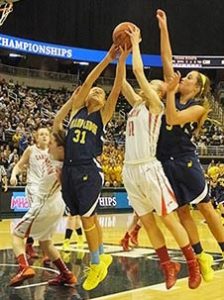Recovering from high ankle sprains
Ankle ligament sprains are the most common cause of sports-related disability. The majority of these injuries are associated with an “inversion” mechanism of injury, which is inward rolling of the outer border of the foot.
 A high ankle sprain is caused by a completely different injury mechanism, typically involving a collision with another player. A force applied to the outer aspect of the lower leg forces the foot and leg to rotate in opposite directions: external rotation of the foot and internal rotation of the leg. The result of this opposite rotation is separation of the binding between the two long bones of the lower leg at the ankle joint (the tibio-fibular syndesmosis).
A high ankle sprain is caused by a completely different injury mechanism, typically involving a collision with another player. A force applied to the outer aspect of the lower leg forces the foot and leg to rotate in opposite directions: external rotation of the foot and internal rotation of the leg. The result of this opposite rotation is separation of the binding between the two long bones of the lower leg at the ankle joint (the tibio-fibular syndesmosis).
Because upward movement of the foot imposes a force that spreads the tibio-fibular articulation, weight-bearing activities that involve combinations of ankle dorsiflexion/eversion and foot external rotation (inward pivoting of the torso and leg upon a fixed foot) stresses the ligaments that bind the tibia and fibula to each other. As little as one to two millimeters of separation between the tibia and fibula produces intense pain and may delay ligament healing.
The absence of any substantial post-injury swelling, combined with the frequent lack of pain during performance of routine daily activities, may be misinterpreted as evidence that an athlete’s ankle injury is relatively minor. If an athlete who has a “high” ankle sprain returns to full participation too soon, susceptibility to re-injury and prolonged recovery is great.
The amount of time required for restoration of normal performance capabilities varies in proportion to the severity of injury to the syndesmotic ligaments and the interosseus membrane between the tibia and fibula. An athlete who has a moderate-severity high ankle sprain may be capable of returning to full participation at two to three weeks following injury, but persistence of functional limitations for six to eight weeks is not uncommon for more severe cases.
Unfortunately, the severity of a high ankle sprain is exceedingly difficult to determine immediately after the injury has occurred, and the rate at which the injured athlete should be allowed to progress to normal weight-bearing activities during the early rehabilitation process is controversial. Some experts advocate a period of complete immobilization of the ankle in a boot device and a relatively slow progression to performance of normal sport-specific activities. Others believe that the injured athlete can be progressed at a faster rate, assuming that the injured ligaments are protected by taping or bracing and that progressively more stressful activities do not elicit pain.
Although risk of re-injury for an athlete whose high ankle sprain has completely healed does not appear to differ from that for a previously uninjured ankle, coaches and athletes should recognize that the risk for re-injury is exceedingly great until the healing process is complete.
An athlete who has regained normal functional capabilities over a period of one to two weeks following a high ankle sprain may sustain a sudden joint load that delays complete recovery from the injury for another one to two weeks. Regardless of whether a high ankle sprain is managed in a conservative versus a more aggressive manner, the potential for re-injury upon return to full participation, especially in a contact sport, is a major concern. Restriction of foot and leg motions that increase vulnerability to re-injury of the tibio-fibular syndesmosis may be accomplished through skillful ankle taping, but the use of a rigid ankle brace offers the additional benefit of a splinting effect that resists external forces that may be applied to the lower leg by opposing players.
An “inversion” mechanism is responsible for most sports-related ankle sprains, which are effectively managed by standard ankle taping or a brace that restricts ankle inversion. A high ankle sprain presents a much more complex injury, which is most effectively managed with a custom-fabricated brace that very closely conforms to the unique contours of the individual’s foot and leg.
Managing high ankle sprains
• Permitting return to full participation in sports whenever the athlete is capable of performing sport-specific skills without pain, accepting a high level of risk for re-injury and delayed recovery.
• Completely restrict activities that could aggravate the injury until ligament healing is complete, despite the athlete’s capability of performing sports-specific skills without pain.
• Protect the damaged tissues from high-stress loads through the use of a custom-fabricated ankle brace, combined with gradual progression in exposure to stressful weight-bearing activities and return to full participation in sport whenever capable of performing without pain.









